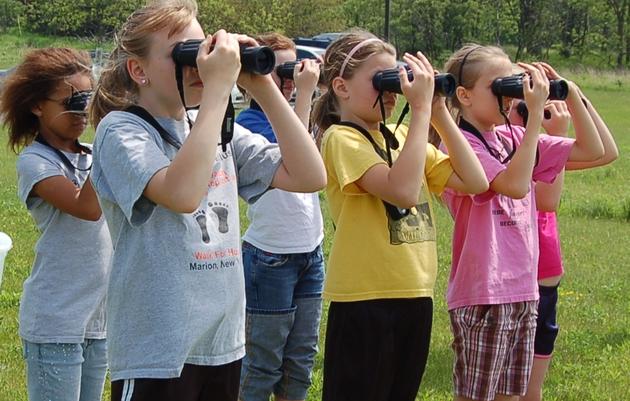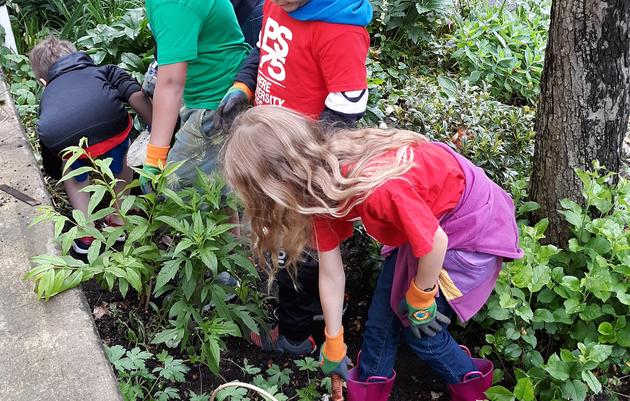“I have 2 pet pigeons who I adopted from Wild Bird Fund, so my students have a great appreciation for pigeons. They really enjoyed the introduction lesson today & asked me, "is there going to be one about pigeons?" so I know they are really looking forward to it!”
Sara Janoff, PS 85, Astoria, Queens
While they don’t typically feature in grand tales of bird adventures, pigeons were one of the first birds to bring joy to New York City students in the trying times of COVID.
Around late March, as soon as it became clear that Audubon—and the world—would not be conducting business as usual, an idea sparked: virtual lessons for teachers, featuring the birds outside their classroom windows. Audubon New York’s For the Birds! staff moved quickly to put together “Pigeon Watch,” featuring a checklist of color morphs and behavior that helped students see the wide variety of life around them.
It was a pivotal lesson, and an important moment for the program’s staff as they pivoted to pre-recorded lessons and live Zoom calls.
“At the end of March, we sent a brief survey out to teachers and got a tremendous response. A majority still wanted lessons to be delivered,” said Program Coordinator Yamina Nater-Otero. “We did presentations on migration and the importance of Central Park to migratory species, hosted virtual neighborhood bird walks, played games to learn bird songs, and so much more.”

The interest was there, but the obstacles loomed large. “Not all students have ready access to internet, or even a computer,” said Environmental Educator Lily Lasovick. “We are currently putting together hundreds of boxes of printed materials for teachers to deliver to students moving forward. In the classroom, there is a sense of equity, but it became immediately clear that once students could no longer attend school in-person, the barriers to equal educational opportunities grew substantially.”
Between March and the end of the school year, For the Birds! delivered these printed and pre-recorded lessons to more than 1,000 elementary school students in 12 schools, and ten live sessions to middle and high school students.
While the numbers look impressive, “The thing I found most surprising were the discrepancies in attendance and engagement within the same school,” said Nater-Otero. “I expected, and saw, discrepancies across districts with socio-economic differences. But while delivering the lessons to a middle school, I had an advanced Regents-level class with full attendance and a special education class with one student in attendance. The barriers to opportunity were obvious, even in the same school.”
In an effort to increase accessibility to their educational materials, the team shared the full suite of lessons produced by Audubon in Spanish, “Audubon para niños,” with the NYC Department of Education (DOE)-- only to find they were the first to share a bilingual resource.
The DOE’s English Language Learners Demographic Report cites: “Over 42% of the 929,088 students enrolled in New York City public schools communicated in a language other than English at home, which means that 396,677 students were living in households where English was not the primary language conversed.” Yet all of the educational content being sent home and shared with local families was in English.
“A little over half of NYC’s English Language Learners are in elementary school, where For the Birds! focuses its work,” said Nater-Otero. “When I heard we were the first organization to submit bilingual resources, I was shocked. How could organizations in NYC, one of the most diverse places in the world, only provide resources in English? It made me proud of the work that we do and served as a reminder that there is more work to be done in making Environmental Education more accessible.”

“It’s been a tough year,” said Lasovick. “We watched a lot of feeder cams, knowing not all the kids could go out or had access to the outdoors. We didn’t get to take them on bird walks in Central Park or Prospect Park. It put a lot of our work in perspective and it's pushing us to think about new models for self-guided activities, print and digital materials, and how to address the needs of the students inside and outside of the classroom.”
To help young people discover birds at home, check out these three For the Birds! lessons featured on Audubon for Kids:
Pigeon Watch!
https://www.audubon.org/news/pigeon-watch-get-know-and-love-our-amazing-...
Birds in Flight: A Paper Airplane Lesson
https://www.audubon.org/news/these-paper-airplanes-fly-birds
Game: Follow a Bird’s Migration Story
https://www.audubon.org/news/game-follow-birds-migration-story






